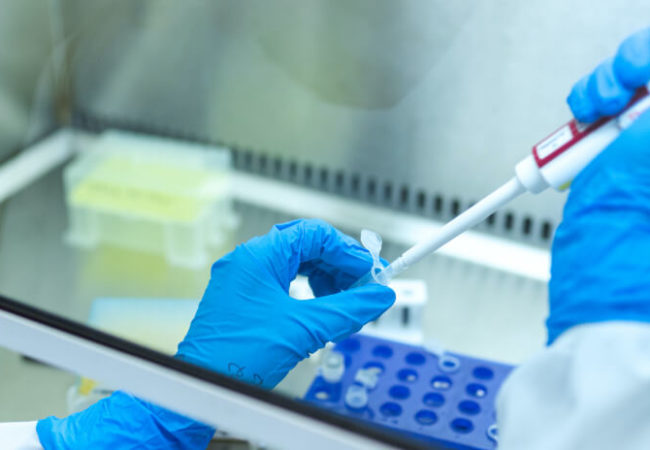Physicochemical

Physicochemical Assays
Pharmaron offers several physicochemical assays to elucidate properties, including solubility, LogD, and chemical stability measurements. Understanding the physicochemical properties of a drug is important both for optimizing future drug development efforts as well as for proper interpretation of in vitro assay results. Poor physicochemical properties can introduce various complications across many assays and must be taken into account to understand the results.
For additional service requests or customization, please contact us.
Available Express Physicochemical Assays:
Solubility – Shake Flask
This assay is used to determine the solubility of a test article at room temperature in aqueous buffer at pH 7.4.
Required from Sponsor
- A minimum of 3 mg of powder
- Exact molecular mass of test article and its salt form
- MSDS or handling and storage information, e.g., light sensitive, store at -20°C, etc.
Deliverables
- The solubility of the test article, in either mg/mL or µM
Substrate
- The test article dissolved in aqueous buffer, pH 7.4, at room temperature
Assay System
- 1.5 mL shake flask
- Solubility range by this method of determination: 1.0 µM to 1.0 nM, depending on analytical sensitivity
Assay Conditions
- This assay is run with a single replicate (n=1)
- Mix >1.0 mg of test article with 1.0 mL of aqueous buffer, pH 7.4
- Equilibrate overnight at room temperature (>16 hours), with shaking
- Filter the solution and sample the filtrate in duplicate (n=2)
- Determine the concentration of test article using a generic LC-MS/MS method with a minimum 6-point calibration curve
Notes
- The results from this assay are sent to the sponsor in the ExpressPlus report format, which may include graphical representations of data and comparison with historical data for reference articles.
- In this assay, it is not determined if a saturated solution is obtained. Thus, the value obtained might not be the true equilibrium solubility of the test article.
- In this assay, neither the recovery nor the stability of test article is determined.
- Unless told otherwise by the sponsor it is assumed that the test article is 100% pure.
LogD – Shake Flask
This assay is used to determine the LogD of a test article at pH 7.4 using the shake flask method.
Required from Customer
- Either a minimum of 100 µL of test article at 10 mM in DMSO or 2 mg of powder
- Exact molecular mass of test article and its salt form
- MSDS or handling and storage information, e.g., light sensitive, store at -20°C, etc.
Deliverables
- The measured LogD for testosterone (internal control) at pH 7.4
- The measured LogD of test article at pH 7.4
Substrate
- Test article and testosterone equilibrated at 100 μM total concentration in equal volumes of phosphate buffer and water-saturated octanol
Assay System
- n-octanol: phosphate buffer at pH 7.4
Assay Conditions
- Single incubation of test article (n=1)
- Mix samples for 1 hour at room temperature, then allow to sit for 1 hour at room temperature
- Sample each phase in duplicate
- Prepare serial dilutions of the organic and aqueous layers
- Determine the concentration of the test article in each phase, using a generic LC-MS/MS method with a minimum 6-point calibration curve
Assay QC
- The LogD of testosterone must be between 3.0 and 3.4 for the test article’s LogD to be accepted
Notes
- The results from this assay are sent to the sponsor in the ExpressPlus report format, which may include graphical representations of data and comparison with historical data for reference articles.
- The LogD value is dependent upon the temperature of the buffer and octanol. The assay is performed at room temperature; we neither monitor nor control the temperature of the aqueous and organic phases.
- This assay can determine the LogD of test articles between approximately -2.0 and 5.0. Data outside this range will be reported as >5.0 or <-2.0.
Stability In Buffer
This assay is used to determine the chemical stability of a test article in buffer.
Required from Sponsor
- Either a minimum of 100 µL of test article at 10 mM in DMSO or 2 mg of powder
- Exact molecular mass of test article and its salt form
- MSDS or handling and storage information, e.g., light sensitive, store at -20°C, etc.
Deliverables
- A table of percent remaining of test article at each time point
- Half-life, as applicable
Substrate
- Test article dissolved in buffer at 1 μM
Assay System
- 50 mM phosphate buffer, pH 7.4
Assay Conditions
- Discrete incubation for each sampling time point (n=1 per time point) in buffer at 37°C
- Add acetonitrile directly to discrete incubation at 0, 15, 30, 60, and 120 minutes
- Use LC-MS/MS to determine the peak area response ratio (peak area corresponding to test article divided by that of an analytical internal standard) without running a calibration curve
Notes
- The results from this assay will be provided to the sponsor in the ExpressPlus report format, which may include graphical representations of data and comparison with historical data for reference articles.
- The buffer is 50 mM phosphate buffer, pH 7.4.
Plasma Stability
This assay is used to determine the stability of a test article in plasma from human, rat, mouse, dog, or monkey.
Required from Sponsor
- Either a minimum of 100 µL of test article at 10 mM in DMSO or 2 mg of powder
- The exact molecular mass of test article and its salt form
- MSDS or handling and storage information, e.g., light-sensitive, store at -20°C, etc.
Deliverables
- A table of percent remaining of test article at each time point
- Half-life, as applicable
Substrate
- Test article at 1 µM dissolved in plasma collected with K2EDTA as the anticoagulant
Assay System
- Plasma from a species specified by the sponsor
- Human: mixed-gender, ≥ 3 donors pooled
- Rat: male Sprague-Dawley, ≥ 3 donors pooled
- Mouse: male CD-1, ≥ 3 donors pooled
- Dog: male Beagle, ≥ 3 donors pooled
- Monkey: male Cynomolgus, ≥ 3 donors pooled
Assay Conditions
- Adjust pH of plasma to 7.4 prior to initiation of the experiment
- Single incubation of test article (n=1) in plasma at 37°C
- Sample a single replicate (n=1) at 0, 15, 30, 60, and 120 minutes
- Use LC-MS/MS to determine the peak area response ratio (peak area corresponding to test article divided by that of an analytical internal standard) without running a calibration curve
Notes
- The results from this assay will be provided to the sponsor in the ExpressPlus report format, which may include graphical representations of data and comparison with historical data for reference articles.
- This assay is often run to develop sample handling protocols for in vivo PK studies.
- To distinguish effects of pH and ionic strength on test article stability from the effects of the biological matrix, it is recommended that stability also be checked in phosphate-buffered saline.
Options
- The sponsor must specify: the species —mouse, rat, dog, monkey or human
This assay is used to determine the stability of a test article in whole blood from human, rat, mouse, dog, or monkey.
Required from Sponsor
- Either a minimum of 100 µL of test article at 10 mM in DMSO or 2 mg of powder
- Exact molecular mass of test article and its salt form
- MSDS or handling and storage information, e.g., light sensitive, store at -20°C, etc.
Deliverables
- A table of percent remaining of test article at each time point
- Half-life, as applicable
Substrate
- Test article at 1 µM dissolved in whole blood collected with K2EDTA as the anticoagulant
Assay System
- Whole blood from a species specified by the sponsor
- Human: mixed-gender, ≥ 3 donors pooled
- Rat: male Sprague-Dawley, ≥ 3 donors pooled
- Mouse: male CD-1, ≥ 3 donors pooled
- Dog: male Beagle, ≥ 3 donors pooled
- Monkey: male Cynomolgus, ≥ 3 donors pooled
Assay Conditions
- Adjust pH of whole blood to 7.4 prior to initiation of experiment
- Single incubation of test article (n=1) in whole blood at 37°C
- Sample a single replicate (n=1) at 0, 15, 30, 60, and 120 minutes
- Use LC-MS/MS to determine the peak area response ratio (peak area corresponding to test article divided by that of an analytical internal standard) without running a calibration curve
Notes
1. The results from this assay will be provided to the sponsor in the ExpressPlus report format, which may include graphical representations of data and comparison with historical data for reference articles.
2. This assay is often run to develop sample handling protocols for in vivo PK studies.
3. To distinguish effects of pH and ionic strength on test article stability from effects of the biological matrix, it is recommended that stability also be checked in phosphate-buffered saline.
Options
- The sponsor must specify: the species of the blood donor—mouse, rat, dog, monkey or human
Other Express Services
Project Deliverables:
- Assay results shared in 5-10 business days
- Report shared through the secure portal
- Data archived in 21 CFR Part 11 compliant portal for posterity
- Easy check out and payment with credit card (Visa, Mastercard, AmEx) or Purchase Order
- Spend more than $25,000 within a calendar year to unlock an additional 10% discount, valid for online purchases only
Place an Online order
To view pricing and place online orders, you must have an account and be logged in.
